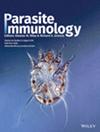重组 CD5 和 CD6 外显子在继发性囊性棘球蚴病中诱导抗寄生虫和免疫调节作用
IF 2.1
4区 医学
Q4 IMMUNOLOGY
引用次数: 0
摘要
清道夫受体与多种非自身配体或改变的自身配体结合后,可参与多种生物功能。其中,CD5 和 CD6 是已知能与不同微生物相关分子模式相互作用的淋巴细胞清道夫受体,在真菌、细菌和棘球蚴感染的实验模型中,服用重组的人 CD5(rshCD5)和/或 CD6(rshCD6)可溶性外显子已显示出治疗/预防潜力。后者是一种人畜共患病,由普通棘球蚴寄生虫的幼虫阶段引起,人类在自发或在原发性包虫囊肿手术切除过程中,可因可育囊肿内的原孢子溢出而诱发继发性囊性棘球蚴病(CE)。在此,我们分析了预防性服用 rshCD5 或 rshCD6 后,在继发性包虫病小鼠模型中观察到的显著保护作用背后的机制。我们的研究结果表明,这两种分子在体外均表现出内在的抗寄生虫活性,并在早期继发性CE期间表现出免疫调节功能,主要是通过Th1/Th17细胞因子偏向和促进腹膜多反应性抗体。这些数据证明了 rshCD5 和 rshCD6 结合的寄生虫成分的相关性,以及预防性服用这两种药物作为减少患者继发性 CE 的有效策略的潜力。本文章由计算机程序翻译,如有差异,请以英文原文为准。
Recombinant CD5 and CD6 Ectodomains Induce Antiparasitic and Immunomodulatory Effects in Secondary Cystic Echinococcosis
Scavenger receptors participate in a wide range of biological functions after binding to multiple non-self or altered self-ligands. Among them, CD5 and CD6 are lymphocyte scavenger receptors known to interact with different microbial-associated molecular patterns, and the administration of the recombinant soluble ectodomains of human CD5 (rshCD5) and/or CD6 (rshCD6) has shown therapeutic/prophylactic potential in experimental models of fungal, bacterial and echinococcal infections. The latter is a zoonosis caused by the larval stage of the cestode parasite Echinococcus granulosus sensu lato, which in humans can induce secondary cystic echinococcosis (CE) after the spillage of protoscoleces contained within fertile cysts, either spontaneously or during surgical removal of primary hydatid cysts. Herein, we have analysed the mechanisms behind the significant protection observed in the mouse model of secondary CE following prophylactic administration of rshCD5 or rshCD6. Our results show that both molecules exhibit intrinsic antiparasitic activities in vitro, as well as immunomodulatory functions during early secondary CE, mainly through Th1/Th17 cytokine bias and promotion of peritoneal polyreactive antibodies. These data support the relevance of the parasite components bound by rshCD5 and rshCD6, as well as the potential of their prophylactic administration as a useful strategy to reduce secondary CE in patients.
求助全文
通过发布文献求助,成功后即可免费获取论文全文。
去求助
来源期刊

Parasite Immunology
医学-寄生虫学
CiteScore
4.70
自引率
4.50%
发文量
61
审稿时长
6-12 weeks
期刊介绍:
Parasite Immunology is an international journal devoted to research on all aspects of parasite immunology in human and animal hosts. Emphasis has been placed on how hosts control parasites, and the immunopathological reactions which take place in the course of parasitic infections. The Journal welcomes original work on all parasites, particularly human parasitology, helminths, protozoa and ectoparasites.
 求助内容:
求助内容: 应助结果提醒方式:
应助结果提醒方式:


